Submitted by Dan Jones (Jonesy)This outlines my experience rebuilding the rear wheel on my '73 CB750 K3. I documented the process so that others interested in wheel lacing would feel less intimidated by it. It's certainly a job you can do yourself. However, bear in mind that these are the wheels that hold your bike (and you) up off the pavement, so judge accordingly if you want to tackle the job or leave it to a pro. In my case, I had the local Honda shop double check my work since this was my first time doing a motorcycle wheel.
Here was the wheel before I started:
Missing: RimBefore-1.jpg
Before dismantling a spoked wheel with the intention of replacing the spokes, it's a good idea to take many detailed pictures of the wheel at different angles so you have a good feel for how the spokes are layed out. Here's one example pic, with the valve stem hole used as a reference point:
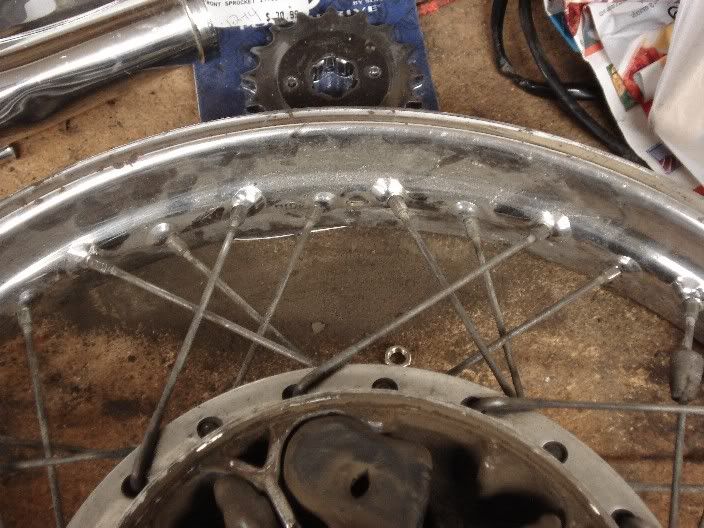
The wheel was taken apart, new rim and spokes purchased and the hub cleaned and polished. Gather the hub, spokes and rim on a spacious and well-lit work surface. Make sure your worktop won't scratch the new parts. The large cardboard disc that was strapped to my new rear tire worked nicely here. You will also need a flat screwdriver, a spoke wrench and a bottle of light oil. Lay out the parts in their general positions:

Now, take a look at your spokes. There are 2 different kinds (20 of each for a CB750 Rear in my case), and they are usually packed in separate bags. Note the difference. The spokes with a slight curve at the end are the inner spokes (pictured at the top), and the ones with a more pronounced hook are the outer ones (shown at the bottom):
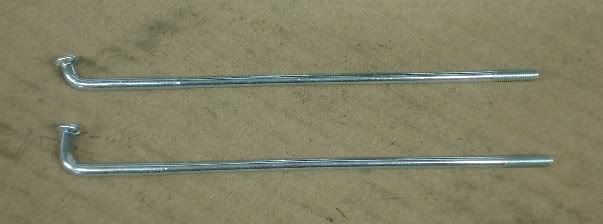
Also, take a close look at the rim. You will see that the spoke holes are angled either upward or downward, and to the left or right. This is important as this will dictate which spokes go in these holes. (More on this in a minute):
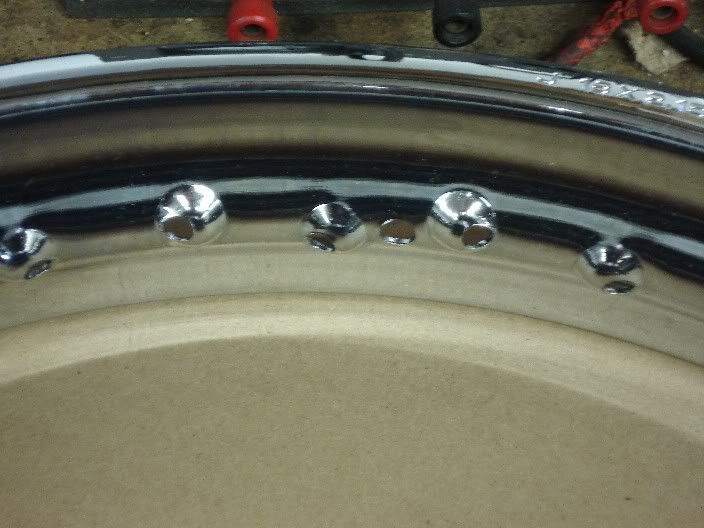
Let's get started. My hub had slight indents worn in it from the outer spokes, so this helped show the layout. Referencing your pictures you took before disassembly (or another wheel, if you have one), thread the first 10 inner spokes into the hub so the buttons on the end face towards the outer part of the hub. As seen in the "before" pictures, the inner spokes on the sprocket side angled to the left. Look at the holes in the rim and find one that is angled upwards and to the right (so the left-angled spoke will point right to it). Put a spoke through this hole, put a small drop of light oil on the tip of the threads and thread the spoke nipple on 4 turns. Now, the next spoke will fit into the fourth spoke hole in the rim. Here's a pic of the first few:
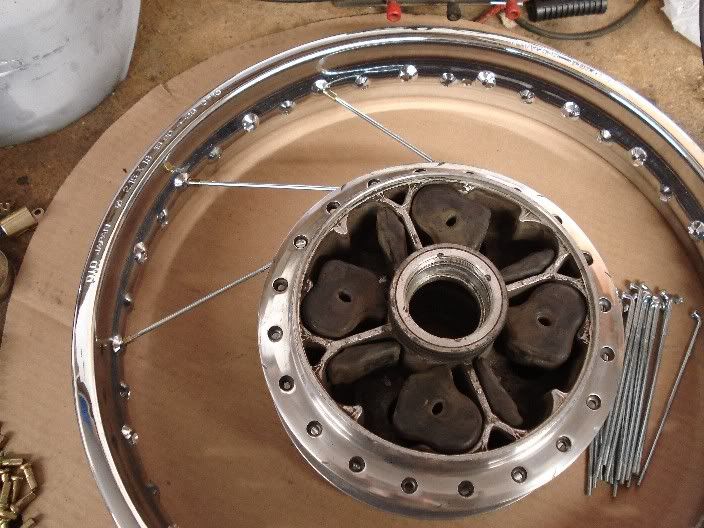
Repeat the process all the way around. When you complete the first set, it will look like this:
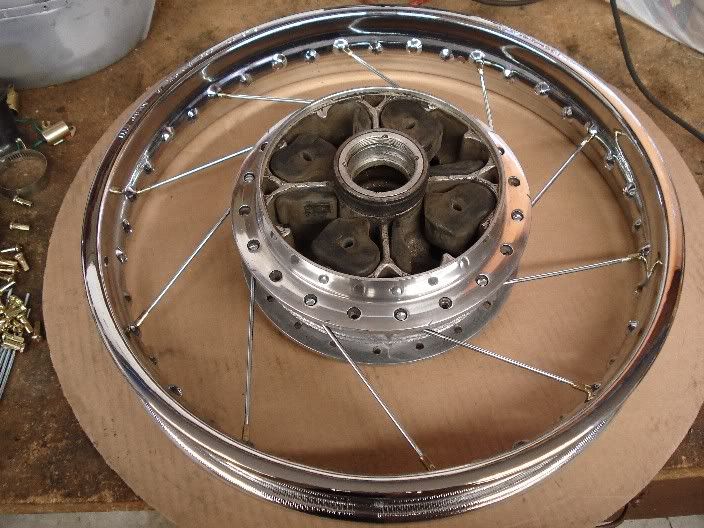
Now, flip the wheel over and do the next set of inner spokes. Once you get them threaded into the hub, make sure they are angled in the appropriate direction and overlapping the first set of spokes on top. This is important as once a few of these are attached to the rim, there won't be enough wiggle room to move the rest of the spokes into the correct position if they are under the existing spokes. See the pic:
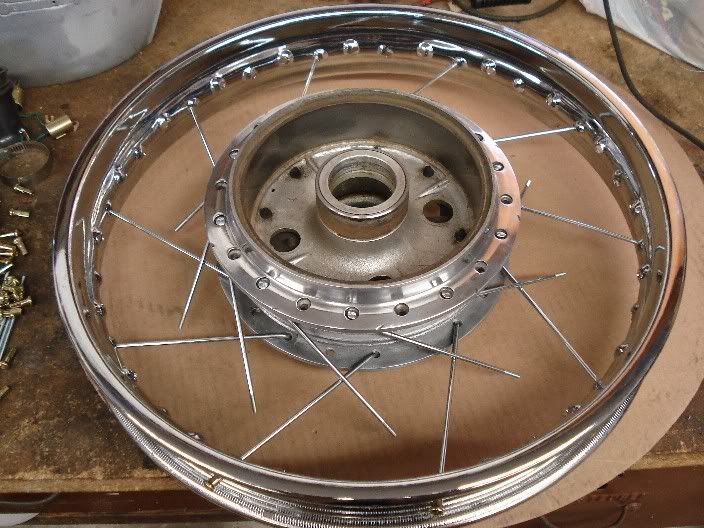
As with the first set of spokes, oil and thread on the spoke nipples 4 turns until you've got all the inner spokes on:

Now we move on to the outer spokes. With the wheel on the same side, thread the first set out outer spokes through the hub, with the buttons on the ends now facing inwards. This set of spokes will be angled in the opposite direction as their inner neighbors. Insert the spokes into the correct holes in the rim (those angled in the correct fashion) and install the spoke nipples as before:

When completed, flip the wheel over and install the last set of spokes.

Yay! We've got all the spokes installed:
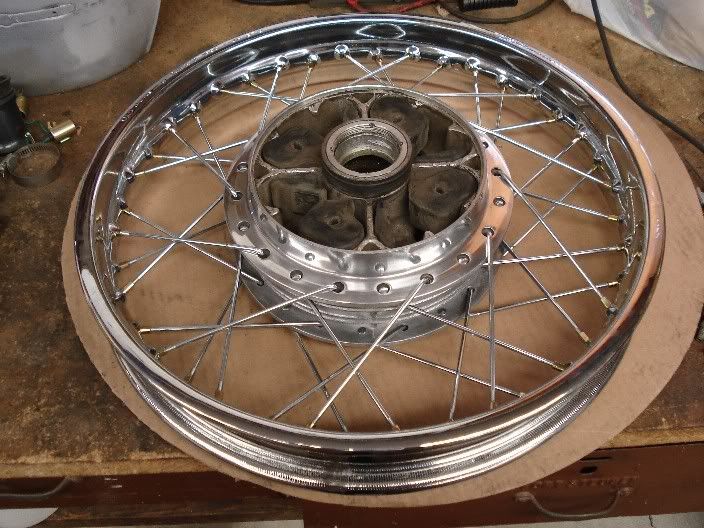
Now, there is still quite a bit of slack in the spokes. We needed this so we could wiggle the hub around in order to fit the ends of the spokes in their respective holes. Put a dab of oil on the head of each spoke nipple. This will aid in tightening.
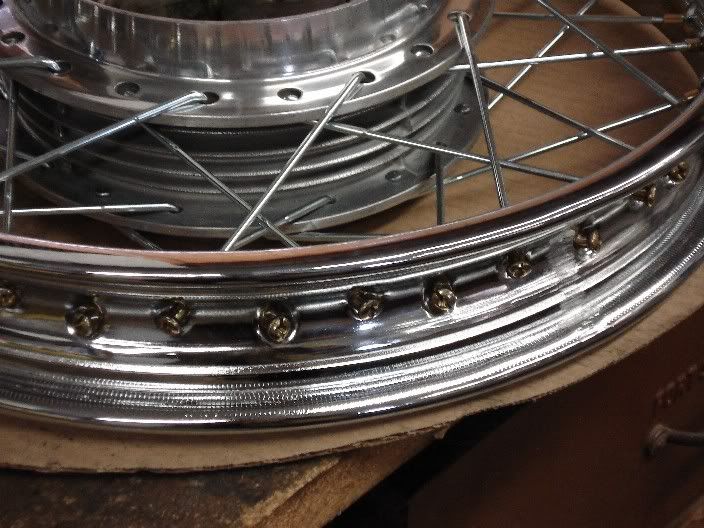
Now we take out the slack. Starting at the valve stem hole, tighten each spoke nipple one at a time with a screwdriver a few turns. The key thing is to tighten each spoke the same number of turns. This will get us in the ballpark for truing the wheel later. Keep working all the way around the rim until the spokes are all just tight. Then, go around the wheel again with a spoke wrench and tighten each spoke a quarter turn. This will ready the wheel for truing and the final tensioning.
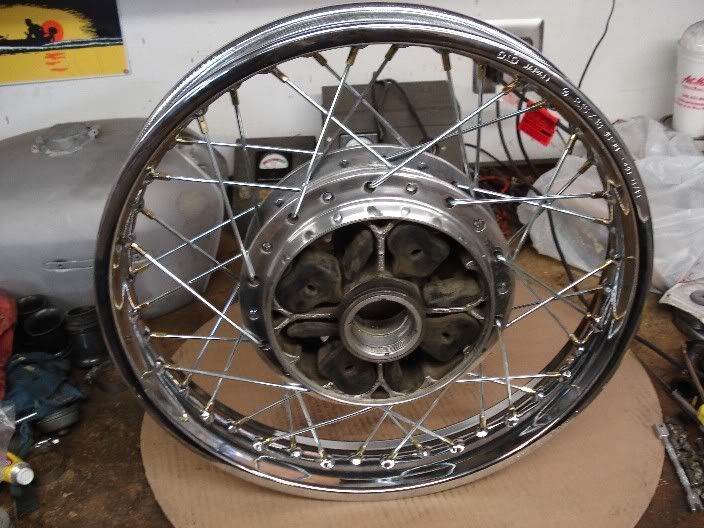
With the wheel bearings installed we can begin the more challenging part- truing the wheel!
First, a few general comments. This is a detail-oriented job. The more patient you are and strive for precision, the better the result will be. Also, while I found remounting the wheel on the swingarm satisfactory, if I was to do it again I'd either borrow or make a truing jig. While you can work on the runout OK, it's tricky to get an exact offset measurement, with the swingarm having tapered sides. Also, if you are working with an older wheel, check the wheel bearings before you start. If the wheel wiggles a bit due to loose bearings it will be very difficult to get accurate results.
To start, assemble the rear axle, including the adjusters, spacers, wheel, brake plate, etc. as you would for final reassembly. Mount the assembled pieces on the swingarm and push the wheel all the way forward so that both sides of the axle are bottomed out in the adjustment slots. Tighten the axle down. You will need a dial indicator (or some form of pointer), a grease pencil or crayon, and a spoke wrench for the next steps.
Give the wheel a spin and look for any runout and get a feel for how the wheel looks. Mine wobbled a bit, despite careful building. (No matter how carefully you build up a wheel, it will always require some tweaking.) We will be working on radial runout (referred to as "hop") and axial runout (called "wobble").
One thing to note before we measure the wheel. Note the area where the rim was welded together. There will be some surface irregularity here (you can feel it when you run your finger over it) from the grinding, etc. during the wheel's production. Ignore this spot:
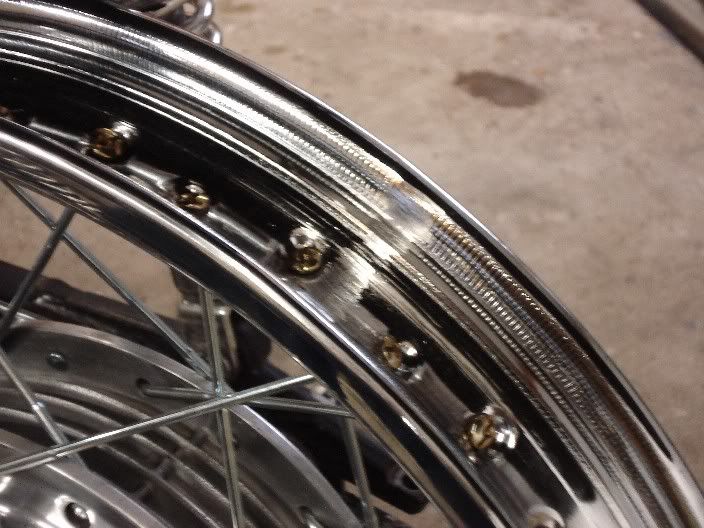
First, check the axial runout. Setup the indicator so that you are measuring either the outer or inner edge of the rim:
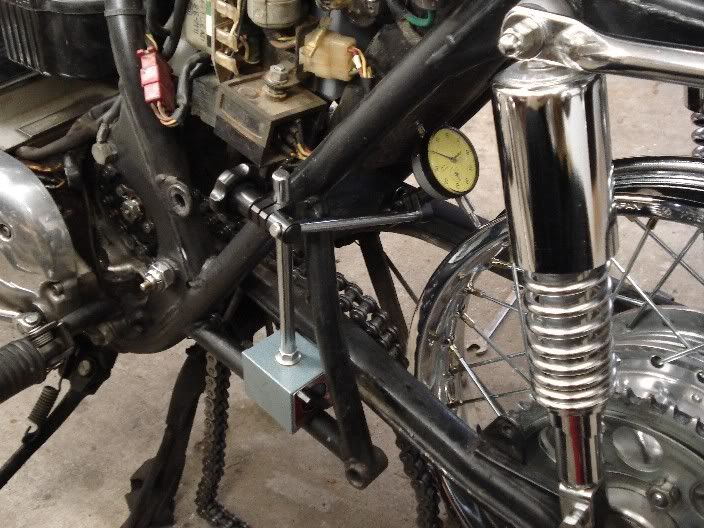
Slowly rotate the wheel and watch the pointer. Note the lowest point and set the dial to "0" at that spot.
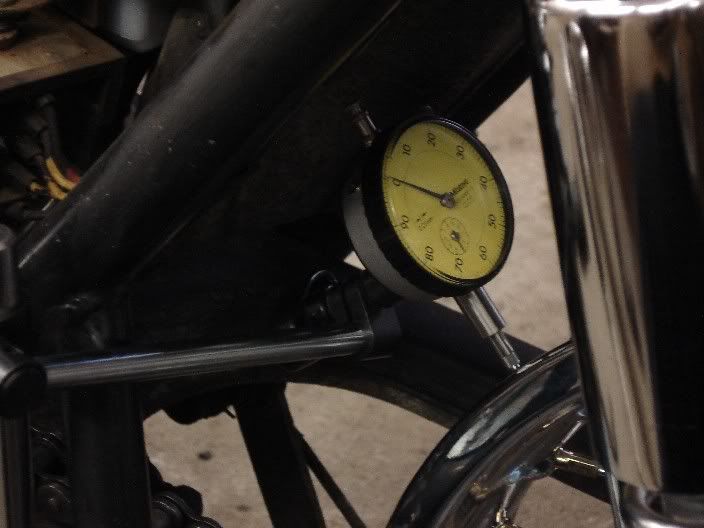
My dial indicator is in millimeters. I gave the wheel a turn and the overall axial runout was just under 2mm. No spec is given in the Honda CB750 Shop manual, but another text gave a general "rough" rule of 1mm, so we have some work to do. Note the highest spot on the rim with your grease pencil and tighten the spokes in this vicinity, going no farther than just under half of the total spokes on the wheel. Tighten the spokes in quarter-turn increments sequentially (meaning the spokes in order, regardless of which side of the hub they go to as the goal is to get even pulling on both sides), rolling the wheel around between each quarter-turn pass to check the progress. If the wheel is showing improvement but the spokes on the high side are getting very tight, proceed to loosen the low-side spokes, again in quarter-turn increments. Keep repeating the "tighten on high, loosen on low" mantra until you cannot get the radial runout any better. This is something that as you go you will get a feel for it, but at first the progress will seem slow. I got my radial runout to just under 0.5mm.
Now, onto axial runout. Setup the dial indicator on the side of the rim:
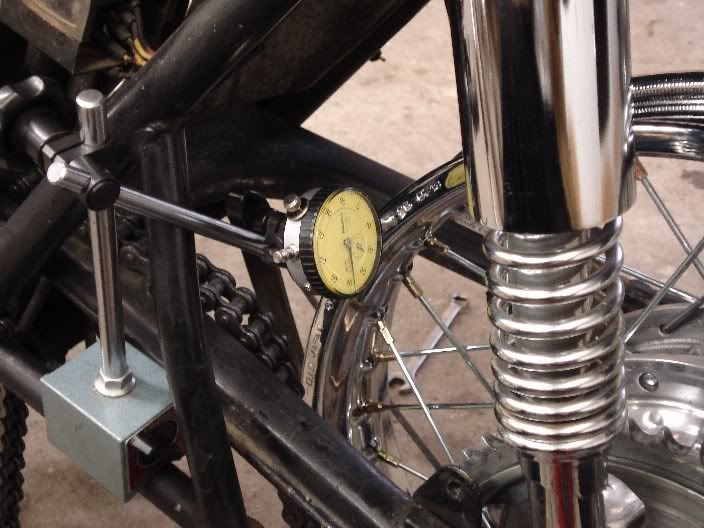
Wipe off the grease pencil marks you made during the previous step and spin the wheel slowly, noting the high and low areas. Zero out the indicator at the low spot. My wheel read 2.5mm, with the Honda spec being 2mm max:
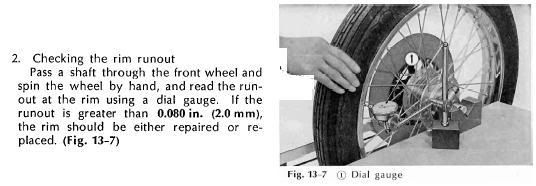
The tighten/loosen routine will be employed here as well, but a bit differently. We will focus on which sides of the hub the spokes are on, as the ones we tighten will pull the rim closer to their respective sides. On the low side, for example, you will work on the 4 or 5 spokes in the lowest spot. Tighten the ones on the side you are measuring from a quarter turn and loosen the spokes going to the opposite side a quarter turn. This allows the rim to move a bit while keeping even tension in that area so we don't mess up the radial runout we just worked so hard to perfect. Do the opposite on the high spot (so the spokes on the other side will pull the rim away from the indicator slightly) and remeasure. I was shooting for 0.5mm or less as another publication gave this is the general rule for wheels to be run over 90 MPH. I don't plan on ever going that fast, but the CB750's top rated speed was 125 MPH, so why not aim high? I find it odd that the shop manual listed a bigger tolerance. The closer you can get the wheel to running true, the better it will be.
When you are satisfied with the axial runout, go back and double check the radial:
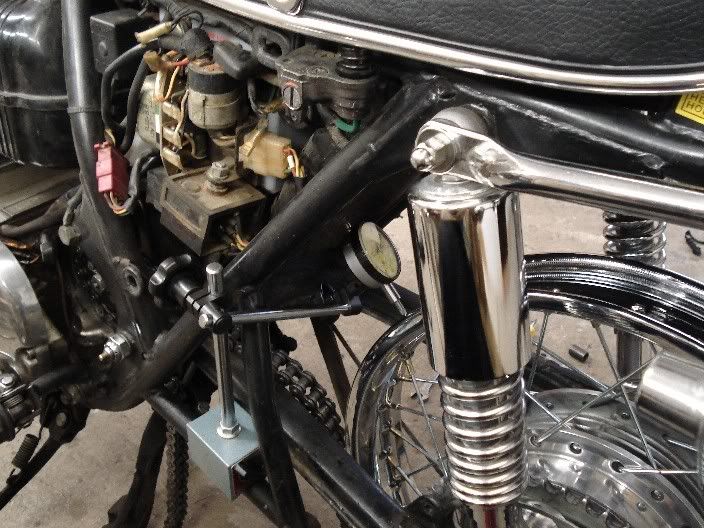
When both the radial and axial runouts check out, go over each spoke and tap it with your wrench. They should all make a nice, clear "ping" sound. If you come across one that makes a "thunk" sound, tighten it up until it pings. Don't worry if all the spokes aren't tuned to the exact same pitch, but they will be fairly close. My wheel plays a bit of a tune, but all the spokes are good and tight.
A word about rim offset. From what I could tell, The rim was evenly spaced in the middle of the swingarm opening. With no solid measuring point it is impossible to get it measured down to the 10th of a millimeter, but just measuring with a ruler indicated it was very close. If you need to pull the entire rim one way, the procedure is just like adjusting the axial runout, except you'd snug up all the spokes on the side you want to pull towards, and subsequently loosen the ones on the other side. As always remeasure after every pass with the wrench! (Refer to the "Thoughts of HondaMan" FAQ for more info here regarding the 750's front wheel offset.)
I took the wheel in to the local Honda shop for the tire mounting, as I was fitting a tubeless-type tire (which are a bear to mount by hand!) and I didn't want to bark up my nice new rim! I'll leave it to the guys with the tire machine.
So, that's my experience. It's a bit hard to describe, as you have to work with it a bit to get the feel for it. The nice (and sometimes frustrating) thing about it is if you mess it up really badly, you can just loosen all the spokes up and start over again. I think I will still ask if the dealer can check them over, just as a double check since this was my first time with this. No publications list any tension spec for the spokes, they all just say they should ring when struck.
Here's the final product after tire mounting and balancing:
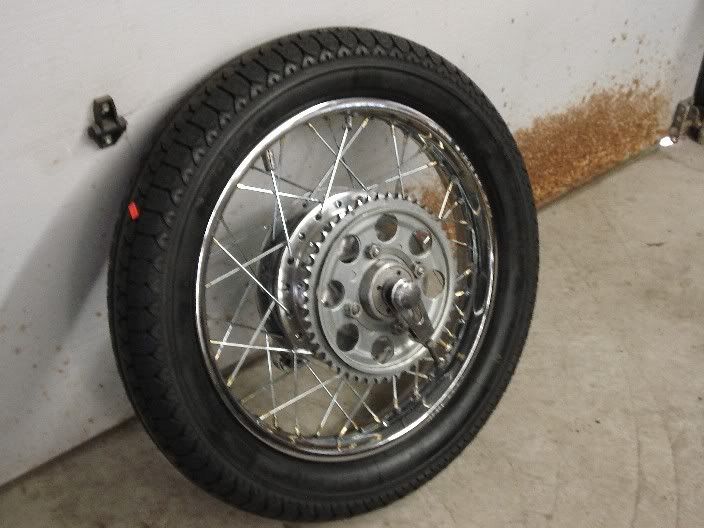
And back on the bike:

One last item. The dealer recommended I re-check the spokes after 100 miles or so after the spokes settle in, just in case any may have loosened a bit. They checked the wheel over and everything was OK. Time for a ride!